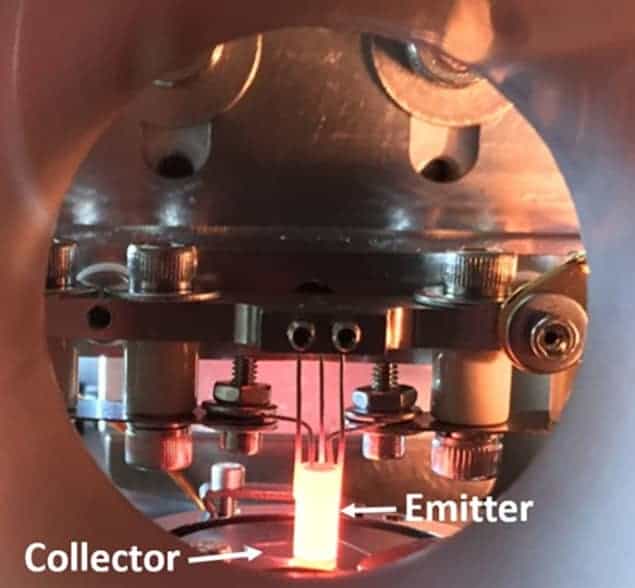
Thermionic energy conversion – a technology first developed in the 1950s to power spacecraft – could soon be significantly more efficient, thanks to two key innovations made by researchers in the US. The work is at an early stage, but the researchers believe that the technology could eventually produce electricity in situations where a traditional steam turbine would not be feasible. As well as making conventional power stations more efficient, the energy conversion could also lead to more environmentally friendly sources of electrical energy.
In the 19th century, physicists noticed that a hot negatively charged filament will tend to discharge in a vacuum, whereas a hot positive filament will not. After J J Thomson’s discovery of the electron in 1897, the British physicist Owen Richardson won the 1928 Nobel Prize for Physics for working out that electrons with enough energy to escape the hot negative electrode will travel through a vacuum to a positive electrode. This can work without an applied potential: electrons escaping the hot electrode (the emitter) move randomly through the vacuum until they are absorbed by the cold electrode (the collector), creating a potential difference between them. In this way, a device can convert a temperature difference into electrical energy. This effect was used in the 1950s to develop small “thermionic energy converters” with no moving parts, for use on-board spacecraft. However, the efficiency of the devices was too low for practical applications on Earth and the technology has fallen into disuse.
Solving two problems
In the new research, Roger Howe and colleagues at Stanford University in California have addressed two efficiency problems that had limited the use of thermionic energy converters. First, they reduced the work function of the collector – which is the energy required to transfer one electron from a material to the vacuum surrounding it. Therefore, an electron entering the material from the inter-electrode vacuum loses this energy to the atomic lattice as heat. The work function of the traditional collector material, tungsten, in the same experimental set-up is 2.15 eV. This dramatically reduces the device efficiency. The researchers utilized the fact that, unlike in metals, the work function of graphene can be tuned by applying a voltage to it with respect to a conductor. They deposited a 20 nm dielectric layer on top of a doped silicon gate, before covering this with monolayer graphene. By applying a voltage to the gate, the researchers increased the electron density in the graphene, reducing its work function to as little as 1.69 eV.
Second, the researchers minimized the space-charge effect, whereby electrons in the gap between electrodes repel each other, pushing electrons back towards the emitter. To reduce this, the researchers used nanofabrication techniques to narrow the inter-electrode gap to 17 μm, ensuring electrons reached the collector as quickly as possible, where they were extracted into the external circuit. As a bonus, it allowed an atomic layer of barium atoms to evaporate from the coating of the tungsten emitter and cover the collector, providing strong surface dipoles that further reduced the work function of the collector.
Big improvement
The researchers estimate that up to 9.8% of the heat radiated from emitter to collector at a temperature difference of 800 °C is converted to electricity – a nearly sevenfold improvement on previous technologies. Other devices have reported higher efficiencies (10–20%), but only by using much higher temperature differences, which can be difficult to sustain in a real device. The researchers are now working to increase the efficiency by reducing the collector work function and inter-electrode spacing further, as well as improving the general device stability.
Team member Hongyuan Yuan says the device might eventually generate electricity from waste heat in the existing power infrastructure, reducing the amount of coal that needs to be burned, for example. It could also generate electricity from renewable sources such as geothermal or solar thermal energy, where a steam turbine would not be viable: “Thermal energy is one of the most abundant energy sources on our planet,” says Yuan: “The only thing needed for this technology to generate electricity is something that’s very hot.”
“What I really like about the work is that it’s focused on some nano-engineering materials, but they’ve developed the whole device for energy conversion,” says Ali Shakouri of Purdue University in Indiana. “Are the results earth-shattering? Not really – but they bring some ideas into a full device and show the principles working.” He adds, however: “On the theory side, this work is weak. Output power can be modelled, and they should tell us ‘OK, the gap decreases from 1 mm to 17 μm and the output power goes up this much – how well does that match theory?'”
The new technology is described in Nano Energy.



